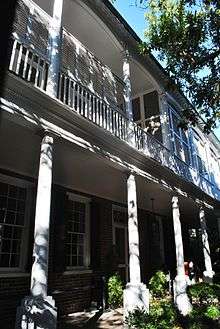St. Philip's Episcopal Church (Charleston, South Carolina)
St. Philip's Church is an historic church at 142 Church Street in Charleston, South Carolina. Its National Historic Landmark description states: "Built in 1836 (spire completed in 1850), this stuccoed brick church features an imposing tower designed in the Wren-Gibbs tradition. Three Tuscan pedimented porticoes contribute to this design to make a building of the highest quality and sophistication."[2] On November 7, 1973, it was added to the National Register of Historic Places and designated a National Historic Landmark. [3][4]
St. Philip's Church | |
U.S. National Historic Landmark District Contributing Property | |
St. Philip's Church | |
  | |
| Location | 142 Church Street, Charleston, South Carolina |
|---|---|
| Coordinates | 32°46′45″N 79°55′45″W |
| Built | 1835-1836, building; steeple, 1848-1850 |
| Architect | Joseph Hyde, building; Edward Brickell White, steeple |
| Part of | Charleston Historic District (ID66000964) |
| NRHP reference No. | 73001695 |
| Significant dates | |
| Added to NRHP | November 7, 1973[1] |
| Designated NHL | November 7, 1973[2] |
| Designated NHLDCP | October 9, 1960 |
History

Established in 1681, St. Philip's is the oldest European-American religious congregation in South Carolina. The first St. Philip's Church, a wooden building, was built between 1680 and 1681 at the corner of Broad and Meeting streets on the present day site of St. Michael's Episcopal Church. It was damaged in a hurricane in 1710 and a new St. Phillip's Church was begun a few blocks away on Church Street. After being delayed it was finished in 1723. It burned to the ground in 1835.[5] Work on the present church was begun that same year and completed the next. The steeple was added between 1848 and 1850.[6][7]
A prominent early rector of St. Philip's was Rev. Thomas Frost, a fellow of Caius College, Cambridge,[8] who became rector of St. Philip's in 1785.[9] Leading the church in the post-Revolutionary War period, he had to create a new role after Anglicanism was disestablished in the United States. Rev. Frost died in 1804 at 46 years of age.[10] Rev. Thomas Downes Frost, son of the first rector Frost, was chosen as assistant minister of St. Philip's on March 12, 1815.[11] The second Rev. Frost died an early death at age 26 in 1819.
Henrietta Johnston, the wife of another early rector, Gideon Johnston, became the first recorded female artist in the American colonies. Mary Roberts, the first female American miniaturist, was connected to the church and buried here in 1761, as recorded in the register.[12]
The tower of St. Philip's served for many years as the rear tower of a set of range lighthouses serving to guide mariners into Charleston's harbor; the front tower of the range was located on Fort Sumter.[13] The light was used from 1893 to 1915.[14] The use was restored temporarily in 1921 when the normal light needed repairs.[15]
Notable burials
Notable burials in the church graveyard include:
- John C. Calhoun, seventh vice-President of the United States.
- Judith DuBose, colonial heiress
- Judith Smith Ladson, colonial society figure
See also
References
- "National Register Information System". National Register of Historic Places. National Park Service. January 23, 2007.
- "St. Philip's Church". National Historic Landmark summary listing. National Park Service. Archived from the original on 2011-06-06. Retrieved 2008-03-23.
- "SCDAH". www.nationalregister.sc.gov.
- Tray Stephenson and Bernard Kearse (April 23, 1973). "National Register of Historic Places Inventory-Nomination: St. Philip's Church" (pdf). National Park Service. Cite journal requires
|journal=(help) and Accompanying two photos, exterior, from 1960 (32 KB) - "Destructive Fire and Conflagration of St. Philip's Church". The Southern Patriot. Charleston, South Carolina. February 16, 1835. p. 2.
- "Welcome to St. Michael's Church - St. Michaels Church - Downtown Charleston, SC - Anglican". St. Michaels Church - Downtown Charleston, SC - Anglican. Archived from the original on 2007-10-09.
- "St. Philip's Church history". Archived from the original on 2006-05-19.
- "Frost, Thomas (FRST775T)". A Cambridge Alumni Database. University of Cambridge.
- Hemphill, James Calvin (1908). Men of Mark in South Carolina: Ideals of American Life: a Collection of Biographies of Leading Men of the State. Men of Mark Publishing Company. p. 157 – via Internet Archive.
charleston south carolina st. philips church frost.
- Frost, Thomas Gold; Frost, Edward Lysander (16 June 2017). "Frost Family in England and America, with Special Reference to Edmund Frost and Some of His Descendants". Russell Print. Company – via Google Books.
- Dexter, Franklin Bowditch (1912). Biographical Sketches of the Graduates of Yale College: With Annals of the College History. Holt. p. 571 – via Internet Archive.
charleston south carolina st. philips church frost.
- Saunders, Richard H. and Ellen G. Miles. American Colonial Portraits · 1700-1776. Washington, D.C.; Smithsonian Institution Press, 1987. pp. 94-97, p. 163
- "St. Philip's to Keep the Light". Evening Post. Charleston, South Carolina. July 25, 1910. p. 7.
- "St. Philip's Light to Be Abolished". Evening Post. Charleston, South Carolina. May 27, 1915. p. 7.
- "Steeple Light Shines Again". Evening Post. Charleston, South Carolina. February 2, 1921. p. 9.
Further reading
- Edward McCrady (1901), An historic church, the Westminster Abbey of South Carolina, Charleston, S.C: Walker, Evans & Cogswell Co., printers, OL 25400019M
External links

- St. Philip's Church website
- St. Philip's Church history
- St. Philip's Church, Charleston County (146 Church St., Charleston), including 9 photos, at South Carolina Department of Archives and History
- National Historic Landmarks Program listing for St. Philip's Church
- National Register listings for Charleston County
- Historic Charleston's Religious and Community Buildings, a National Park Service Discover Our Shared Heritage Travel Itinerary
- Saint Philip's Church - Charleston, South Carolina, includes photos and history